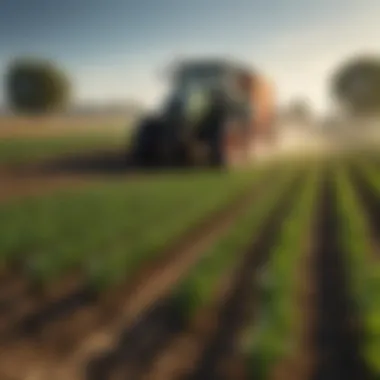In-depth Exploration of Farming Herbicides


Intro
Farming herbicides play a crucial role in modern agriculture. They are designed to control unwanted plants, making it easier for farmers to manage their crops. This article takes a thorough look at herbicides, exploring various aspects such as types, application methods, and their impacts on both agriculture and the environment. As farming becomes increasingly advanced, understanding herbicides is essential for those involved in agriculture.
Key Concepts and Terminology
Basic Definitions
Herbicides are chemical substances used to kill or inhibit the growth of unwanted plants, commonly referred to as weeds. They target specific pathways in plants, making them effective at controlling weed populations without damaging crops. This specificity defines different categories of herbicides, such as selective and non-selective herbicides. Selective herbicides target specific weed species, while non-selective ones affect all plants they contact.
Historical Context
The use of herbicides dates back to the early 20th century. Initially, farmers relied on manual methods for weed control. However, as the agricultural demand grew, chemical solutions emerged. The introduction of synthetic herbicides, such as 2,4-D, revolutionized farming, allowing for larger-scale crop production and more efficient land use. Over the decades, herbicide development continued, presenting both advances and challenges in agricultural practices.
Recent Innovations and Trends
Technological Advancements
Recent innovations in herbicide formulations and application technologies have enhanced their effectiveness. For example, the development of glyphosate-resistant crops has allowed farmers to use glyphosate while minimizing crop damage. Precision agriculture also plays a role in optimizing herbicide application, utilizing technology to determine the exact amount needed for specific areas.
Sustainable Practices
As environmental concerns rise, there is a shift toward sustainable herbicide practices. Integrated Weed Management (IWM) combines cultural, mechanical, and chemical methods to manage weeds, reducing reliance on herbicides. This approach promotes healthier ecosystems and more resilient agriculture.
Practical Applications and Techniques
Step-by-step Guides
- Identify Target Weeds: Understanding which weeds are present is crucial for selecting the right herbicide.
- Choose the Right Herbicide: Based on the weed type, choose a selective or non-selective herbicide.
- Read Labels Carefully: Instructions on application rates and safety precautions must be followed precisely.
- Apply at Optimal Times: Timing can significantly affect effectiveness. Applying herbicides during specific growth stages increases the success rate.
- Monitor and Adjust: After application, monitor crop and weed growth to adapt future strategies as needed.
Case Studies
Numerous case studies illustrate the effective use of herbicides. For instance, a soybean farmer in Iowa successfully implemented glyphosate-resistant seeds alongside glyphosate application to control a persistent ragweed issue. This approach resulted in a remarkable decrease in weed populations and improved soybean yields.
"Utilizing herbicides selectively can improve not only yields but also the sustainability of our farming practices."
Understanding Herbicides
The exploration of herbicides is vital as they play a critical role in contemporary agriculture. Understanding herbicides involves recognizing their essential functions and the various types available. This knowledge supports farmers and agronomists in making informed decisions to enhance crop productivity while managing obstinate weeds. Each aspect of herbicides, from their definitions to their types, possesses unique characteristics that are beneficial for achieving agricultural goals.
Definition and Purpose
Herbicides are chemical substances used to control unwanted plants, commonly referred to as weeds. These substances are fundamental in modern farming practices as they help maintain crop health and yield. Farmers apply herbicides to minimize competition from weeds, which consume vital nutrients, water, and light necessary for crops. Effective management of these unwanted plants can lead to better growth rates, optimized harvests, and increased profitability for farmers.
Types of Herbicides
Herbicides can be categorized based on various criteria, including their application timing and selectivity. Understanding these types is essential for effective weed management strategies. The primary categories include:
Pre-emergent Herbicides
Pre-emergent herbicides are designed to prevent weed seeds from germinating. They are applied to the soil before the crops or weeds emerge. The key characteristic of pre-emergent herbicides is their ability to form a barrier in the soil, inhibiting weed growth. These herbicides are popular choices for farmers who aim to minimize weed problems before they start.
The unique feature here is their application timing, which allows for proactive weed control. However, their effectiveness can vary based on soil moisture and temperatures.
Post-emergent Herbicides
Post-emergent herbicides are applied after the weeds have emerged and are actively growing. The key characteristic is their targeted action against existing weeds. This type of herbicide is beneficial as it allows farmers to address weed infestations at the moment they occur. The unique feature of post-emergent herbicides lies in their flexibility, as they can be used at various growth stages of both the crop and the weeds.
One disadvantage, however, is that timing is crucial. If applied too late, their effectiveness can diminish.
Selective Herbicides
Selective herbicides are designed to target specific types of weeds without harming the desired crops. Their key characteristic is selectivity, which allows for the removal of unwanted plants while preserving crop integrity. This type of herbicide is often favored in crop systems where preserving the crop is critical.
The unique advantage of selective herbicides is their ability to manage weeds strategically. However, one potential drawback is that they may not control all weed species effectively.


Non-selective Herbicides
Non-selective herbicides kill all plant material that they come into contact with, making them an effective choice for total vegetation control. The key characteristic of non-selective herbicides is their broad-spectrum effectiveness against all plants, which can be useful in preparing fields for planting.
Their unique feature helps in eliminating unwanted vegetation entirely, which is advantageous in certain agricultural practices. However, their downside is the potential for damaging desired crops if they are misapplied.
The Science Behind Herbicides
Understanding the science of herbicides is crucial for anyone involved in agriculture. This section explains how herbicides function and their chemical makeup. The knowledge gained here can lead to more effective use, improved crop health, and sustainable farming practices. Furthermore, a solid grasp of herbicide science contributes to better decision-making, ensuring that farmers can manage weeds without causing harm to their crops or the environment.
Mechanisms of Action
Herbicides operate through distinct mechanisms, which can be classified into two primary modes: systemic and contact action.
- Systemic Herbicides: These are absorbed by the plant and translocated to other parts. They disrupt specific physiological functions, leading to plant death. A common example is glyphosate, which inhibits a pathway essential for plant growth.
- Contact Herbicides: These act on the surface of the plant and generally kill only the part of the plant touched by the application. They are effective against annual weeds and can prevent them from establishing.
Different herbicides might target various processes. Some disrupt protein synthesis, while others interfere with photosynthesis. This specificity is vital for achieving desired effects while minimizing non-target harm. Understanding these actions is essential for optimizing herbicide application and enhancing weed control strategies.
Chemical Composition
The chemical make-up of herbicides determines their effectiveness and safety. Most herbicides are classified by their active ingredients, which dictate their mode of action and environmental impact.
Herbicides can be grouped based on their chemical structure into families including:
- Aminopyralid: A selective herbicide used for broadleaf weed control in cereals.
- Atrazine: Often used in corn to control pre-emergent and post-emergent weed species.
- Glyphosate: A broad-spectrum systemic herbicide widely recognized for its use in various crops.
These compounds consist of carbon, hydrogen, oxygen, and often chlorine or nitrogen. The chemical bonds and molecular arrangements dictate how they interact with plant systems, affecting both efficacy and potential environmental behavior.
In addition to the active ingredients, inert ingredients play a critical role. They enhance the herbicide's performance by aiding in distribution and absorption. As such, recognizing the full chemical profile of herbicides is crucial for informed usage.
"The proper understanding of herbicides' mechanisms and compositions can directly influence agricultural success and environmental stewardship."
Application Methods
Application methods are a critical aspect of employing herbicides effectively in farming. The way herbicides are applied can significantly influence their effectiveness and impact on both crops and the environment. Understanding various application methods ensures maximum weed control while minimizing potential negative side effects.
Spraying Techniques
The most common application methods for herbicides include spraying techniques and mechanical applications. Both have distinct advantages and can be selected based on specific crop needs and farm conditions.
Ground Spraying
Ground spraying involves applying herbicides directly to the soil or crop surfaces using equipment on the ground. This method is characterized by its versatility and precision. One key characteristic of ground spraying is the ability to control the application rate and target specific areas, which reduces waste and enhances efficacy.
Ground spraying is popular among farmers for several reasons:
- Flexibility: The application can be customized for different terrains and crop types.
- Accuracy: Farmers can avoid overspray and better target weeds.
However, there are some disadvantages to consider. Ground spraying may be less effective in wet soil conditions, where machinery can compact the soil or damage young crops. Additionally, the equipment can be costly to purchase and maintain.
Aerial Spraying
Aerial spraying is the process of applying herbicides from an aircraft or drone. This method is especially useful when dealing with large fields or when ground access is limited. Aerial spraying is characterized by its ability to cover vast areas quickly.
Aerial spraying is an advantageous choice for the following reasons:
- Speed: Aerial application is typically faster than ground methods, allowing for timely intervention against weeds.
- Access: It can reach crops that are difficult to access for ground equipment.
Despite its benefits, aerial spraying presents a few challenges. The uniformity of application can be affected by wind conditions, and high costs may deter some farmers from using this method regularly.
Mechanical Application
Mechanical application encompasses the use of various equipment to apply herbicides, such as tillers, cultivators, and specialized machines. This method can enhance the efficiency of herbicide distribution while reducing the potential for drift into non-target areas.
Key characteristics of mechanical application include:


- Soil Incorporation: Some mechanical methods allow for mixing herbicides into the soil, improving efficacy.
- Reduced Drift: Because the application occurs closer to the ground, there is a lower chance of wind dispersal to unintended areas.
However, mechanical application requires careful planning and can be labor-intensive, possibly leading to increased operational costs.
In summary, choosing the right application method for herbicides is crucial in managing weed populations effectively in agriculture. Each method has its benefits and drawbacks, requiring farmers to assess their specific conditions and needs before making a decision.
Impact on Crop Production
The impact of herbicides on crop production cannot be overstated. They have played a crucial role in modern agriculture, offering a balance between maintaining productive fields and controlling unwanted flora. This section focuses on the specific benefits their usage brings to crop output, as well as the notable concerns that arise from reliance on herbicides.
Benefits of Herbicide Use
Enhanced Crop Yields
Enhanced crop yields are often cited as a primary benefit of using herbicides. This is largely due to the reduction in competition for resources such as nutrients, water, and sunlight. By effectively controlling weed populations, farmers can ensure that their crops have unimpeded access to these resources. The result is higher productivity per acre, which is crucial in meeting the food demands of a growing global population. The key characteristic of this benefit is its direct link to the efficiency of herbicide application in maximizing land use.
Furthermore, herbicides allow for a more controlled growing environment. Without significant weed presence, crops can grow stronger. However, reliance on herbicides also raises questions about sustainability. Continuous use can lead to resistance and reduced effectiveness over time.
Reduced Labor Costs
Reduced labor costs are another significant advantage of herbicide use. The application of these chemicals often requires less manual labor compared to traditional weeding methods. Labor efficiency is increased, as farmers can focus on other essential tasks that contribute to the overall productivity of their operations. The cost savings here are notable; with fewer hands needed in the field, farmers can allocate resources effectively.
However, it is important to also consider the potential drawbacks. In regions dependent on labor-intensive weeding practices, a shift to herbicides can lead to job loss. Thus, while cost-saving is a benefit, the social implications warrant consideration.
Effective Weed Control
Effective weed control is fundamental in crop production systems. Herbicides provide a robust means of eliminating undesirable plants that compete with crops. The characteristic of selectivity in some herbicides allows farmers to target specific weed species without harming the desired crops. This effectiveness translates directly into increased yields and overall crop health.
Nonetheless, over-reliance on herbicides may lead to problem weeds developing resistance to these chemicals. This resistance can reduce their effectiveness, forcing farmers to explore alternative controls or higher application rates, thus increasing costs in the long run.
Drawbacks and Concerns
While there are many advantages to herbicide use, there are significant concerns that need to be addressed as well.
Herbicide Resistance
Herbicide resistance is a growing problem and a consideration for farmers worldwide. It refers to the phenomenon where certain weed species evolve to survive applications of previously effective herbicides. This resistance can lead to increased herbicide usage and higher costs, as farmers may need to explore alternative solutions or use combination products.
This aspect is critical because it emphasizes the need for integrated weed management strategies. Continuous reliance on single-mode herbicide applications ultimately undermines their long-term efficacy.
Impact on Soil Health
The impact on soil health is another major concern associated with herbicide use. Herbicides can alter the microbiome of the soil, affecting beneficial organisms that contribute to soil fertility. Healthy soil is vital for sustainable agricultural practices, and compromised soil health may lead to diminished crop yields over time.
Moreover, certain persistent herbicides can remain in the soil for extended periods, further complicating the soil’s ecological balance.
Effects on Biodiversity
The effects on biodiversity are particularly pronounced. Herbicide use can detrimentaly impact non-target species, leading to reduced plant diversity and affecting insect populations, including pollinators. Healthy ecosystems require a variety of organisms to function effectively. A decline in biodiversity can create a ripple effect, impacting crop pollination, ecosystem resilience, and food webs overall.
Ultimately, balancing herbicide use with the need to maintain a healthy ecosystem is necessary for sustainable agriculture practices.
Approaching herbicide applications with caution and awareness is essential for fostering a more sustainable agricultural future.
Sustainable Alternatives to Herbicides
The discussion surrounding sustainable alternatives to herbicides is becoming increasingly crucial in modern agriculture. As farmers navigate the challenges posed by weed management, they also face public and regulatory scrutiny surrounding the environmental impact of synthetic herbicides. Implementing sustainable practices offers benefits not only to crop production but also to the ecosystem at large.
One of the primary advantages of sustainable approaches is the promotion of healthy soil and biodiversity. This enhances long-term agricultural productivity by ensuring that the land remains fertile and resilient against pests and diseases. Furthermore, sustainable alternatives often reduce the reliance on chemical inputs, mitigating the risk of herbicide resistance that farmers currently encounter.
When considering sustainable alternatives, it is vital to assess various methods, each versatile in addressing weed control while maintaining an ecological balance. Below, we discuss two prominent strategies: Integrated Weed Management and Organic Farming Practices.
Integrated Weed Management
Integrated Weed Management (IWM) represents a holistic approach to weed control. This method combines multiple management strategies to create a more sustainable and effective system for tackling weeds. Farmers implementing IWM often utilize a mix of cultural, mechanical, biological, and chemical practices tailored to their specific needs.


Some key components of IWM include:
- Crop rotation: Alternating crop types can disrupt weed life cycles, reducing their overall prevalence.
- Cover cropping: This practice helps prevent weed growth by covering soil and reducing light accessibility.
- Selective herbicide application: When herbicides are necessary, targeting specific weeds with appropriate timing can minimize environmental impact and reduce resistance.
Utilizing these tactics creates a resilient ecosystem where weeds face multiple control strategies, leading to more sustainable agricultural practices.
Organic Farming Practices
Organic farming practices offer a compelling alternative to conventional herbicide use. These methods prioritize natural inputs and processes to manage weeds effectively. By fostering a diverse agricultural ecosystem, organic farming can improve soil health and reduce weed pressure.
Some of the prominent organic practices include:
- Manual weeding: Physically removing weeds remains one of the most straightforward methods. While it can be labor-intensive, it is effective at preventing seed production.
- Mulching: Applying organic materials, such as straw or wood chips, can suppress weed growth by blocking sunlight and retaining soil moisture.
- Natural herbicides: Some farmers opt for natural herbicides derived from plant extracts, which can serve as a temporary solution without the harmful side effects of synthetic chemicals.
Through the implementation of organic practices, farmers can effectively manage weeds while fostering environmental sustainability and supporting healthier food production systems.
"The integration of sustainable alternatives is not merely a trend; it is an essential evolution in agricultural practices that aligns economic viability with ecological stewardship."
Adopting sustainable methods is not only about increasing yields but also ensuring that farming practices remain viable in the long term. The shift towards such alternatives is necessary for balancing productivity with ecological integrity while addressing the contemporary challenges posed by herbicides.
Regulatory Framework and Safety
Understanding the regulatory framework surrounding herbicides is crucial for ensuring their safe usage in agriculture. This section explores the various elements that shape these regulations, the benefits they bring to farming practices, and important considerations for stakeholders in the agricultural sector.
Approval Process for Herbicides
The approval process for herbicides involves several strict steps that must be followed before a herbicide can be used commercially. This process ensures that any herbicide on the market has undergone rigorous testing for both safety and effectiveness. First, manufacturers must conduct a series of studies to determine the herbicide's potential effects on human health and the environment. These studies often require years of data collection.
Regulatory bodies, such as the Environmental Protection Agency (EPA) in the United States, review the submitted data. They assess any risks associated with the herbicide's use, evaluating its toxicity, potential for groundwater contamination, and its impact on non-target organisms. If the herbicide meets safety standards, it may be registered for use. However, registration does not end the scrutiny. Ongoing monitoring is essential as new data emerges about the herbicide's long-term effects.
The approval process is vital because it helps protect not only consumers but also farmers and the broader ecosystem from potentially harmful substances. It assures that the products available on the market have been evaluated extensively, providing a level of confidence to all stakeholders.
Safety Guidelines for Application
Implementing safety guidelines for herbicide application is essential for minimizing risks during their use. First, farmers must adhere to label instructions, which provide crucial information about dosage and timing. Using the correct amount is vital. Overapplication can lead to soil degradation and contamination of water sources.
Farmers should also prioritize protective equipment when applying herbicides. This include gloves, masks, and protective clothing to minimize direct contact with chemicals. Additionally, it is important to plan applications during favorable weather conditions. Avoiding windy conditions reduces the risk of drift, which can affect nearby crops and ecosystems.
Training is also a significant aspect of safety. Farmers and workers should undergo proper training on the safe handling and application of herbicides. This training often covers:
- Understanding the risks associated with specific herbicides
- Emergency measures in case of accidental exposure
- Proper disposal methods for empty containers to prevent environmental contamination.
"Safety is not just a guideline but a responsibility for every farmer while using herbicides."
In summary, adhering to safety guidelines protects not only the individuals applying the chemicals but also the surrounding environment. It is an integral part of responsible farming practices.
Future Trends in Herbicide Use
The landscape of agriculture is evolving, and the role of herbicides within it is undergoing significant transformation. Understanding future trends in herbicide use is essential in navigating the complexities of modern farming. This knowledge impacts not only agronomy practices but also environmental sustainability and regulatory compliance. Increased demand for food production, paired with growing public concern over environmental impacts, drives these trends.
Advancements in technology and a focus on sustainability will shape herbicide applications in the coming years. The integration of innovative scientific developments could lead to the creation of herbicides that are more effective yet less harmful to the ecosystem. Therefore, keeping up with future trends is vital for farmers and agronomists to ensure they adopt practices that align with both safety and productivity.
Advancements in Biotechnology
Biotechnology is at the forefront of transforming agricultural practices. In the realm of herbicides, it offers promising avenues for development. Genetic engineering allows for the production of crops that are resistant to specific herbicides, thus minimizing crop damage. This technology can lead to more targeted weed management strategies.
Some notable advancements include:
- Herbicide-tolerant crops, such as those genetically modified to withstand glyphosate. This allows farmers to apply these herbicides without damaging the crops themselves.
- Bioherbicides, derived from natural organisms like fungi or bacteria, provide an eco-friendlier option. These alternatives typically focus on specific weed species without broad-spectrum effects.
Moreover, research in precision agriculture is enabling farmers to apply herbicides more efficiently. This means using data-driven approaches to apply the right amount of herbicide in urban on crop needs, which can reduce waste and environmental impact.
Emerging Research and Development
As the agricultural sector faces more stringent regulations, ongoing research and development become crucial. Researchers are exploring innovative herbicide formulations that are effective while posing less risk to non-target species, including beneficial insects and soil microorganisms.
Key areas of research include:
- New active ingredients that break down more rapidly in the environment, thus reducing residual impact.
- Integration of biological methods alongside chemical applications to enhance weed control while maintaining biodiversity.
In addition, collaborative research efforts between universities, private industry, and government agencies are crucial for creating sustainable herbicide solutions. These partnerships often focus on developing strategies that ensure long-term effectiveness, such as crop rotation practices that reduce reliance on chemical weed control.
"The future of herbicides hinges on balancing agricultural efficiency and environmental stewardship. It’s vital for farmers to stay informed and adapt to these innovations."













